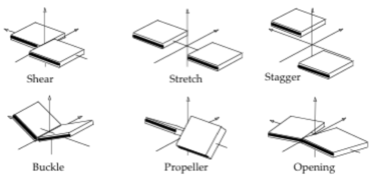DNAflexsuite is a suite of tools to predict DNA flexibility from sequence at different resolutions. The three tools included in DNAflexsuite are base on different models of DNA flexibility:
- the Rigid Base-Pair model (RBP);
- the Stiffening Spring Model (SSM);
- the Rigid Base model (RB).
These three models are parameterised starting from similar data, namely long-timescale Molecular Dynamics simulations of naked B-form DNA oligomers. Nevertheless the tools provide three different views on DNA flexibility. From a practical point of view, the differences lie in their definition of flexibility and their accuracy and speed of execution.
The flexibility of a B-form DNA oligomer is predicted in the form of a stiffness matrix as a function of the well-known and widely used inter base-pair Curves+ helical parameters of DNA (Lavery 2009) (see Figure 1).

Figure 1: Inter-base pair parameters; slabs represent adjacent base pairs. Image courtesy of Curves+.
These represent a set of independent coordinates, 6 for each base-pair step, as a function of which covariances are calculated on long-timescale atomistic MD simulations (Hospital 2013) in order to parameterise the RBP model. Entries of the oligomer-level covariance matrices referring to a single base-pair step (corresponding to 6x6 diagonal blocks) are taken to be sequence-dependent at the tetranucleotide level, and their inverses are used to build block-diagonal oligomer-level stiffness matrices for arbitary-sequence oligomers. For an
Predicts the flexibility of a canonical B-form DNA oligomer of arbitrary sequence in the form of a vector of tetranucleotide variances in Cartesian space. SSM predictions are based on atomistic MD-derived, Cartesian coordinate tetranucleotide variances, but take into account the stiffening effect of conformational frustration between overlapping tetranucleotides. A nearest-neighbour approximation of this perturbation makes SSM prediction effectively hexanucleotide-dependent. The SSM is extremely fast, so that the flexibility of millions of base pairs can be predicted quickly using information from atomistic simulations, and used for example as a physics-based track in genome annotation.
Flexibility of B-form DNA is described in a similar way to the RBP model, but in this case the coordinates used to describe DNA also include the Curves+ intra base-pair helical parameters of DNA (Lavery 2009) (see Figure 2).

Figure 2: Intra-base pair parameters; slabs represent paired bases. Image courtesy of Curves+.
This finer discretisation of the conformational space of DNA results in improved accuracy and provides a more detailed picture of DNA flexibility. The cgDNA model is unique among existing coarse-grain models of DNA in that it predicts ground states with a nonlocal sequence dependence, despite its parameter set having at most dinucleotide dependence. In this respect, cgDNA provides a natural model for the frustration of pre-existing stress in a molecule, in analogy to the SSM (Gonzalez 2013). For an
[Lavery 2009] Lavery,R., Moakher,M., Maddocks,J.H., Petkeviciute,D. and Zakrzewska,K. (2009) Conformational analysis of nucleic acids revisited: Curves+. Nucleic Acids Res., 37, 5917-5929.
[Hospital 2013] Hospital,A., Faustino,I., Collepardo-Guevara,R., Gonzalez,C., Gelpi,J.L. and Orozco,M. (2013) NAFlex: a web server for the study of nucleic acid flexibility. Nucleic Acids Res., 41, W47-W55.
[Pasi 2016] Pasi,M., Triantafyliou,S., Shkurti,A. and Laughton,C.A. (2016) in preparation
[Gonzalez 2013] Gonzalez,O., Petkeviciute,D. and Maddocks,J.H. (2013) A sequence-dependent rigid-base model of DNA. J Chem Phys, 138, 055102.
[Petkeviciute 2014] Petkeviciute,D., Pasi,M., Gonzalez,O., and Maddocks,J.H. (2014) cgDNA: a software package for the prediction of sequence-dependent coarse-grain free energies of B-form DNA. Nucleic Acids Res., 42, e153-